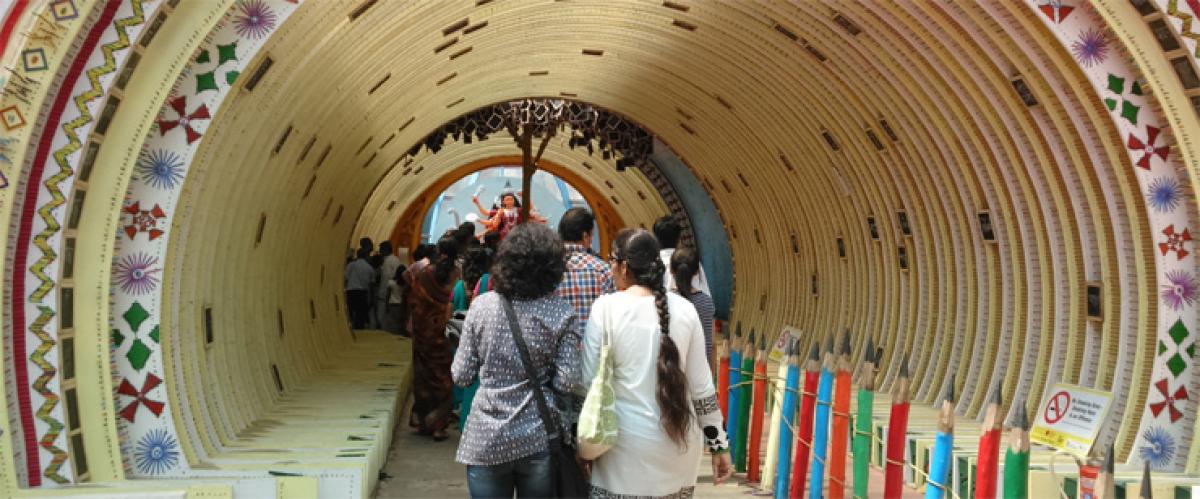Live
- Allu Arjun Released from Chanchalguda Jail, says he respects law
- Jesus is synonymous with sacrifice, forgiveness: Ponnam
- HC announces verdict in Kannada for the first time
- Uttam releases water from Nizam Sagar for Rabi crop
- TG to be Rs 84L cr economy in 10 years: Sridhar Babu
- First TGCHE, V-Cs meet deliberates on higher education roadmap for state
- 2 senior professors to join NALSAR
- Former Principal of SPW College passes away in US
- Hyderabad: Govt out to remove electric poles, transformers on roads across city
- KCR goes into huddle with State legal eagles
Just In

x
Highlights
Known for its sheer scale and variety, this year\'s Durga Puja celebrations, however, will tug at your heartstrings and nudge you to reflect on some controversial global issues.
Known for its sheer scale and variety, this year's Durga Puja celebrations, however, will tug at your heartstrings and nudge you to reflect on some controversial global issues.
.jpg)
Right from Nepal earthquake to GM foods to the historic Indo-Bangladesh enclave swap, a section of organisers has decided to address the challenge of introducing somewhat complicated concepts for the public. After all, the biggest festival in east India is not confined to religious beliefs, but has a societal role too.
In support of that aspect of the pujas, Kasba Sakti Sangha will provide pandal-hoppers a chance to peep into the lives of the erstwhile enclave dwellers, two months after the historic exchange between India and Bangladesh.
Amid Kolkata's concrete jungle, a slice of rural life from Mashaldanga, which was the biggest Bangladeshi enclave in India before the borders dissolved, has been recreated with at least 60 clay and wood figures.
In the works since a year, organisers aim to draw attention to the concerns of the people along the Indo-Bangladesh border.
"Since residents in urban areas do not have an idea about their problems, it will be a good opportunity to gain insights," Sangha joint secretary Sanat Kr. Mukherjee told IANS.
But the essence of the theme will be conveyed to visitors through interactions with around 12 former enclave dwellers (now Indian nationals), who have been specially invited for the celebration.
"They will talk about their experiences before the swap and will also shed light on concerns regarding rehabilitation post the exchange," said Raktim Das, who spearheaded the media campaign regarding the enclaves.
In addition to Bangladesh, India's Himalayan neighbour, Nepal, has also found its space.
Scenes from earthquake-ravaged Nepal and India's timely help to the nation will be depicted in clay at the Kumartuli Park Sarbojanin Durgotsab Committee's puja grounds in north Kolkata.
The organisers hope to impress upon visitors the importance of humanity and compassion through life-sized models of a hovering Indian Air Force helicopter and Indian Army personnel carrying out relief and rescue amid the rubble in Nepal.
"We are making a damaged temple modelled on the lines of those typical in Nepal as well as the houses. The idol is crafted from clay but will look as if it's made from stone, similar to what can be seen in Nepal," said artist-in-charge Mintu Paul.
One will also get to experience how an earthquake feels, courtesy light and sound effects in combination with vibrating motors.
From human rights to disasters, next in line is biology but with a nostalgic dose of literature.
Marrying art, literature and science, the Tala Barowari Durgotsav will depict genetically modified organisms (GMO) and hybrids to raise awareness about public health concerns and the environmental risks surrounding engineered foods.
The organisers plan to take the idea forward in sync with the October 2 "March Against Monsanto" global campaign.
The goal: informed food choices.
"The majority does not know that GMO products or transgenics have entered our food system. Consumers will be able to make an informed choice about GM products if there is proper labelling on packages," Avishek Bhattacharya, working secretary of the puja that is in its 95th year, told IANS.
So how does one simplify GMO? Easy.
The organisers have turned to Bengali poet and playwright Sukumar Ray's famous collection of poems "Abol Tabol" (Rhymes without Reason).
The rhymes brim with fantastic creatures, including hybrid animals, and continue to be the staple of children's literature in West Bengal. Sukumar Ray was the father of Indian filmmaker Satyajit Ray.
For example in the rhymes, there is a parrot-faced lizard, a 'duckupine' (a cross between a duck and porcupine) and a lion that sprouts deer horns.
"On those lines, there will be 3D structures over 20 feet depicting crossbreed plants and animals. In addition, information on GMO crops and their reported health effects will also be prominently displayed," Bhattacharya said.

Next Story
More Stories
ADVERTISEMENT
© 2024 Hyderabad Media House Limited/The Hans India. All rights reserved. Powered by hocalwire.com







